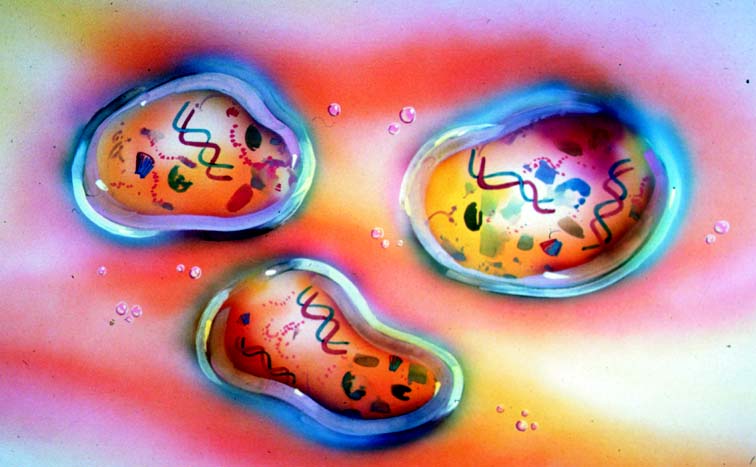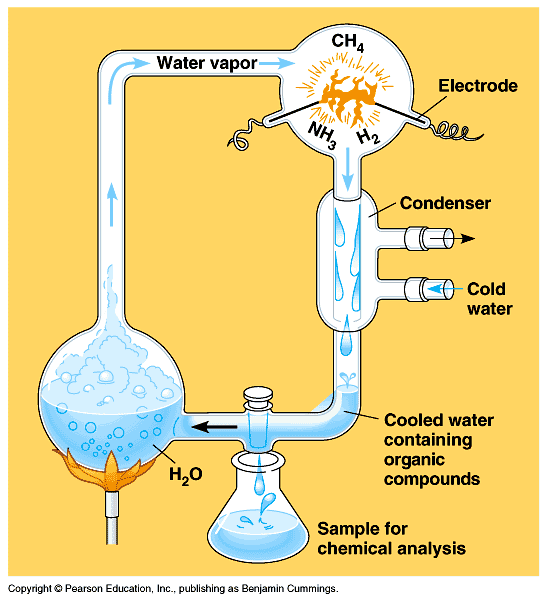
RESOURCE · 7/12/2023
Abiogenesis
It is a discussion on the ideas of how pre-historic life began on this planet.

This Article is yet to be approved by a Coordinator.

RESOURCE · 7/12/2023
It is a discussion on the ideas of how pre-historic life began on this planet.

 \n\n\nThe Chemical origin of life or abiogenesis is the natural process by which life has arisen from non-living matter, such as simple organic compounds. The prevailing scientific hypothesis is that the transition from non-living to living entities on Earth was not a single event, but a process of increasing complexity involving the formation of a habitable planet , the prebiotic synthesis of organic molecules, molecular self-replication, self-assembly , and the emergence of cell membranes. Many proposals have been made for different stages of the process.\n\n---\n\n### Prebiotic Synthesis Of Organic Molecules\n\nPrebiotic organic synthesis is a plausible pathway for the formation of the molecular precursors of life on early Earth. These precursors include amino acids, bases, and ribose phosphates.Prebiotic molecules react with water and ammonia or nitrogen to form more complex organic molecules. These molecules include:\n\nAmino acids, Fatty acids, Urea, Aldehydes, Sugars, Nitrogenous bases (purines and pyrimidines).\n\nThese molecules can act as reactants in further organic syntheses leading to the formation of:\n\n* Carbohydrates \n* fats and lipids\n* Proteins\n* RNA and DNA\n\nThe prebiotic atmosphere can supply chemical ingredients and facilitate environmental conditions that contribute to the synthesis of organic compounds. For example, potential compounds involved in the origin of life were synthesized in the Miller-Urey experiment.\n\n
\n\n\nThe Chemical origin of life or abiogenesis is the natural process by which life has arisen from non-living matter, such as simple organic compounds. The prevailing scientific hypothesis is that the transition from non-living to living entities on Earth was not a single event, but a process of increasing complexity involving the formation of a habitable planet , the prebiotic synthesis of organic molecules, molecular self-replication, self-assembly , and the emergence of cell membranes. Many proposals have been made for different stages of the process.\n\n---\n\n### Prebiotic Synthesis Of Organic Molecules\n\nPrebiotic organic synthesis is a plausible pathway for the formation of the molecular precursors of life on early Earth. These precursors include amino acids, bases, and ribose phosphates.Prebiotic molecules react with water and ammonia or nitrogen to form more complex organic molecules. These molecules include:\n\nAmino acids, Fatty acids, Urea, Aldehydes, Sugars, Nitrogenous bases (purines and pyrimidines).\n\nThese molecules can act as reactants in further organic syntheses leading to the formation of:\n\n* Carbohydrates \n* fats and lipids\n* Proteins\n* RNA and DNA\n\nThe prebiotic atmosphere can supply chemical ingredients and facilitate environmental conditions that contribute to the synthesis of organic compounds. For example, potential compounds involved in the origin of life were synthesized in the Miller-Urey experiment.\n\n \n\n----\n\n### Self-Assembly \nNow that we have discusssed how the precursors of organic chemicals might have formed , now let's discuss how these chemicals might have assembled to form complex structures that would have been necessary for the early organisms to exist.\n\n#### Plasma Membrane : \n\nThe plasma membrane physically separates the cytoplasm of living cells from the extracellular environment and hence maintains the physical integrity of the cell.The plasma membrane consists of a complex mixture of components, among which lipids are the major building blocks.Since lipids contain a hydrophilic (polar head group) and a hydrophobic part (fatty acyl chain) they are considered as amphiphilic molecules. Exposed to water, lipids compact their hydrophobic parts in the energetically most favourable way, forming a hydrophobic core . This simple principle underlies the self-organization of lipids in an aqueous environment, e.g. in living cells as well as in artificial membrane systems.\n
\n\n----\n\n### Self-Assembly \nNow that we have discusssed how the precursors of organic chemicals might have formed , now let's discuss how these chemicals might have assembled to form complex structures that would have been necessary for the early organisms to exist.\n\n#### Plasma Membrane : \n\nThe plasma membrane physically separates the cytoplasm of living cells from the extracellular environment and hence maintains the physical integrity of the cell.The plasma membrane consists of a complex mixture of components, among which lipids are the major building blocks.Since lipids contain a hydrophilic (polar head group) and a hydrophobic part (fatty acyl chain) they are considered as amphiphilic molecules. Exposed to water, lipids compact their hydrophobic parts in the energetically most favourable way, forming a hydrophobic core . This simple principle underlies the self-organization of lipids in an aqueous environment, e.g. in living cells as well as in artificial membrane systems.\n \n\n\n#### RNA ( genetic material ) \n\nSo how did RNA evolve on Earth? Scientists think RNA building blocks (nucleotides) emerged in a chaotic soup of molecules on early Earth. These nucleotides bonded together to make the first RNAs. No sooner were they made than they broke down; however, new ones were made in their place. Some RNAs turned out to be more stable than others. These RNA strands grew longer and bonded nucleotides more quickly. Eventually, RNA strands grew faster than they broke down. This was RNA’s chance to start life. In a study, published in Nature Communications and funded by the Engineering and Physical Sciences Research Council, the Simons Foundation and the Origins of Life Challenge, researchers from UCL, Harvard University and Massachusetts General Hospital suggest a single chemical mechanism by which both classes of nucleotides - purines and pyrimidines - could have formed together.\n\n
\n\n\n#### RNA ( genetic material ) \n\nSo how did RNA evolve on Earth? Scientists think RNA building blocks (nucleotides) emerged in a chaotic soup of molecules on early Earth. These nucleotides bonded together to make the first RNAs. No sooner were they made than they broke down; however, new ones were made in their place. Some RNAs turned out to be more stable than others. These RNA strands grew longer and bonded nucleotides more quickly. Eventually, RNA strands grew faster than they broke down. This was RNA’s chance to start life. In a study, published in Nature Communications and funded by the Engineering and Physical Sciences Research Council, the Simons Foundation and the Origins of Life Challenge, researchers from UCL, Harvard University and Massachusetts General Hospital suggest a single chemical mechanism by which both classes of nucleotides - purines and pyrimidines - could have formed together.\n\n \n\n#### Proteins \nThe first proteins were likely small, simple peptides. These peptides were made up of amino acids, which were available on primitive Earth. Amino acids are organic molecules that have a basic amino group, an acidic carboxyl group, and an organic R group.The first proteins may have formed when amino acids were heated in evaporating tidal pools or underwater hydrothermal vents. The heat caused the amino acids to react and form proteins. These proteins are called thermal proteins.The first proteins may have also formed when amino acids spontaneously created sticky assemblies called peptides. The peptides would have bound together over time to form proteins.\n
\n\n#### Proteins \nThe first proteins were likely small, simple peptides. These peptides were made up of amino acids, which were available on primitive Earth. Amino acids are organic molecules that have a basic amino group, an acidic carboxyl group, and an organic R group.The first proteins may have formed when amino acids were heated in evaporating tidal pools or underwater hydrothermal vents. The heat caused the amino acids to react and form proteins. These proteins are called thermal proteins.The first proteins may have also formed when amino acids spontaneously created sticky assemblies called peptides. The peptides would have bound together over time to form proteins.\n \n\n----\n\n### Conclusion \nSo we have discussed how the organic chemicals might have formed, and how these chemicals might have assembled into protobionts ( the first and most primitive living organisms ) . this sums up abiogenesis . Though this theory is not yet completely verified and does contain a lot of speculations , this is the most widely accepted one among other theories like spontaneous generation , panspermia or special creation. This is the result of centuries of human ingenuity and dedication to solve one of the biggest mysteries known to man : Where did we come from?
\n\n----\n\n### Conclusion \nSo we have discussed how the organic chemicals might have formed, and how these chemicals might have assembled into protobionts ( the first and most primitive living organisms ) . this sums up abiogenesis . Though this theory is not yet completely verified and does contain a lot of speculations , this is the most widely accepted one among other theories like spontaneous generation , panspermia or special creation. This is the result of centuries of human ingenuity and dedication to solve one of the biggest mysteries known to man : Where did we come from?